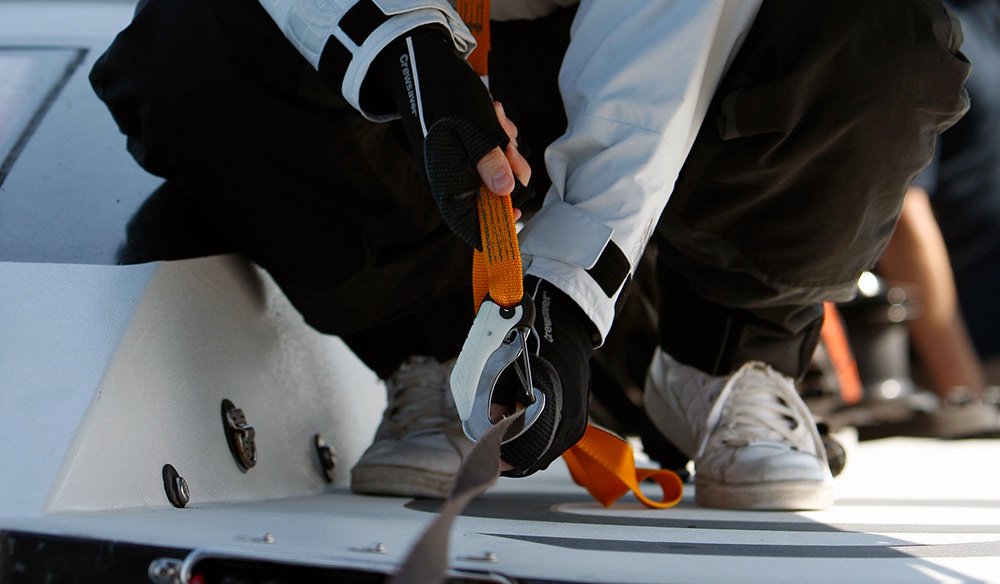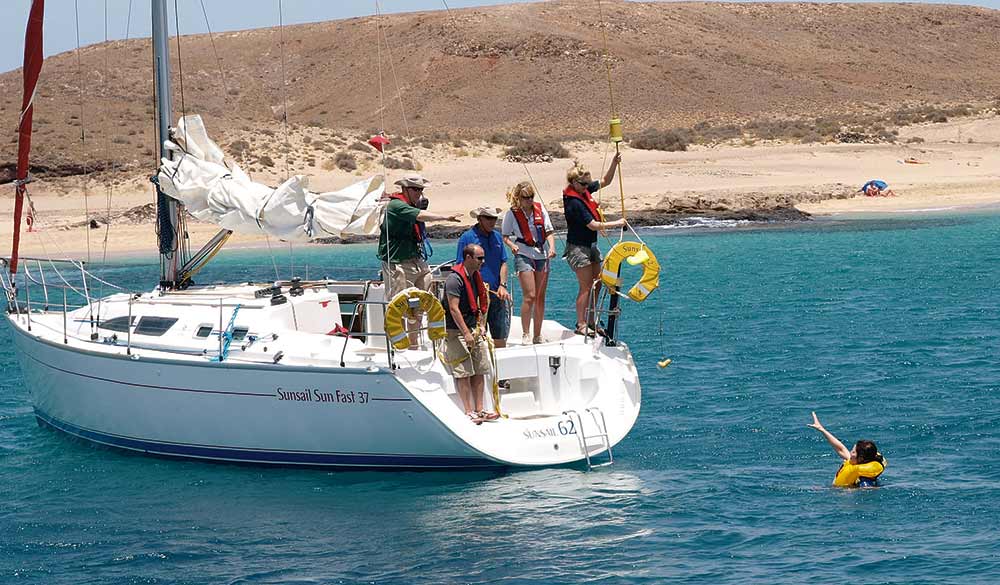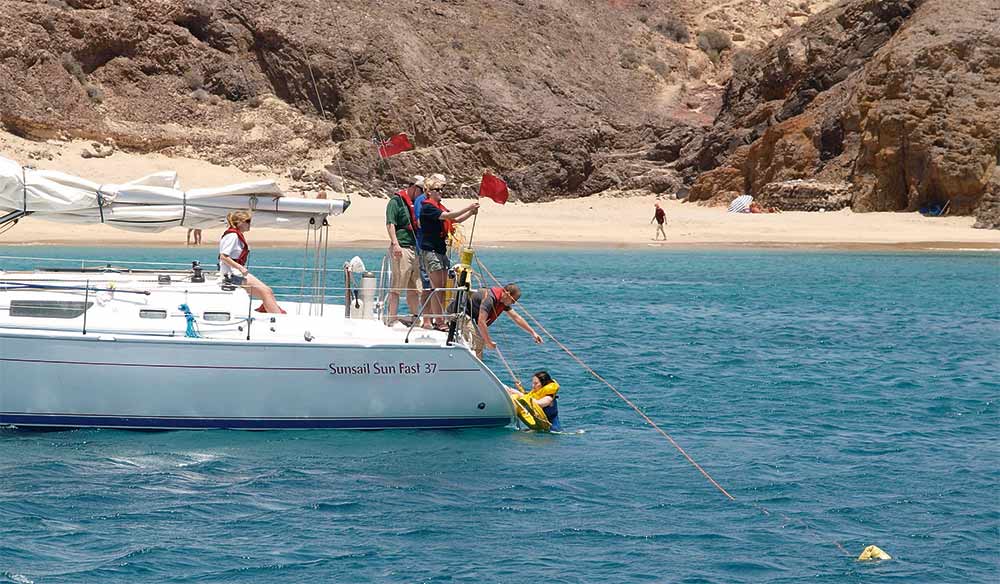Man overboard
The exclamation ‘man overboard’ refers to a crew member or a passenger falling into the water and needing immediate rescue
.jpg?w=100%25&hash=CAEFE30E68555953AC8BF254DDB56F03)
Research by the Maritime Accident Investigation Branch (MAIB) has shown that crews have, on average, less than 11 minutes to recover a crewmate who has fallen overboard into cold water before the victim becomes unresponsive.
This time decreases as the water becomes colder, or the sea state rougher. In some cases, crew had just four or five minutes to coordinate a complex recovery under extreme pressure.
Sadly more than 40% of man overboard occurrences reported to the MAIB between 2015 and 2023, tragically led to a fatality. A startling reminder of the importance of getting all your crew trained and having a well-practised plan.
Read on for more information about prevention, and how to prepare for a man overboard occurrence.
Man overboard prevention
Before setting off, ensure all crew receive a thorough safety briefing. This should include, moving along the high side of the vessel, keeping one hand for yourself and one for the boat, and clipping on. When clipping on, use a tether that’s the right length and secured to a purpose made strong point or jackstay.
If conditions deteriorate, reef early or slow down if on a power or motorboat. Consider directing crew who are less experienced or agile, to remain in safer areas such as the cockpit or cabin.
Provide clear directions and guidance to those who may need to venture out of the cockpit for hoists, drops, anchoring, and other tasks.

Man overboard whilst attached
A safety line offers the advantage of keeping a casualty attached to a vessel. This avoids the need for a search and any potentially challenging manoeuvres to reach the man overboard. However, being attached does come with its own hazards.
Where a casualty is attached to the boat and in the water, the priority must be to stop the boat altogether. Any movement through the water, even at very low speed, must be avoided as it risks forcing water into the casualty’s lungs.
If unable to stop the boat or remove the casualty from the water, carefully consider cutting the tether and coming back to them with the boat at a standstill.
Man overboard unattached
In this situation, time is of the essence. In water of 15 degrees Celsius or less there is a risk of cold water shock, which can result in cardiac arrest or other medical issues.
When faced with a man overboard situation in which the casualty is unattached, the first step is raising the alarm to the crew.
Appoint a spotter to maintain visual contact with the casualty and deploy a danbuoy or life rings to mark the spot and provide buoyancy.
Press the man overboard button on the plotter to provide a last known position and issue a MAYDAY or DSC Alert. Try to stop the boat or reduce your speed to avoid further man overboard situations.
Prepare your recovery equipment and reassure the casualty that you will be returning to them.
Think through your approach to reach the casualty. Aim to position your vessel upwind of them, so that as you slow down the vessel is blown towards them. Always ensure the crew is properly briefed on your next steps during recovery.

Alongside and recovery
Once alongside the casualty, it’s important to ensure that engines are left in neutral or switched off. Whether or not you switch off the engine depends on weather conditions, your vessel, or a variety of other factors. Regardless, risk to the casualty from a spinning propellor must be avoided at all costs.
If the casualty is conscious and can assist in their recovery, throw a heaving line to help recover them. A scramble net, rescue ladder, boarding ladder, or swim platform on the stern (calm conditions only) can be useful in helping to recover a man overboard.
Depending on your vessel, you can use a halyard, block and tackle from the boom, dedicated lifting device or a davit coupled with a lifting strop. Recovery can also be aided with the inflation of a life raft or over the side of a RIB or tender.

Unconscious casualty
Where the casualty is unconscious, the recovery becomes far more challenging. A crew member will need to secure a lifting device to the casualty’s lifejacket or harness.
In this situation, other crew members will be at risk reaching overboard or being lowered towards the casualty to make contact. This is an extremely challenging situation for a skipper and crew, involving decisions that should not be made lightly.
When lifting a casualty onboard, they should remain in a horizontal position to avoid the potential medical complications caused by hydrostatic squeeze. However, drowning remains the primary risk, therefore recovery onboard is the priority.
Onboard casualty management
Once the casualty is onboard, they need to be carefully monitored. First aid needs to be provided and for non-breathing or unconscious casualties all the appropriate steps should be taken.
Conscious casualties or those who have recovered themselves are at risk of shock, hypothermia, secondary drowning, and injuries incurred during their fall or recovery.
Wet clothing should be removed, and the casualty should be warmed, carefully monitored, and transported to a medical facility for review.
Get trained
It’s important to prepare for the unexpected. If the man overboard is the skipper, is anyone else onboard properly trained to take control and manage the recovery?
Anticipating what could go wrong and then practicing is the best form of preparation to avoid emergencies and keep you and your crew safe.
However, if you lack the confidence to develop these skills yourself, RYA specialist training courses can equip you with the skills and knowledge to save a life.
The RYA’s Helmsman, Competent Crew and Day Skipper courses are the perfect way to build your confidence and enhance your skills.
For more information on staying safe on the water, visit the RYA safety hub.
